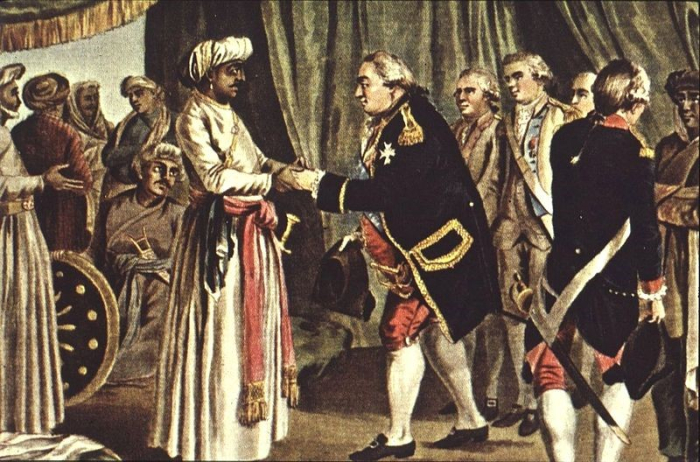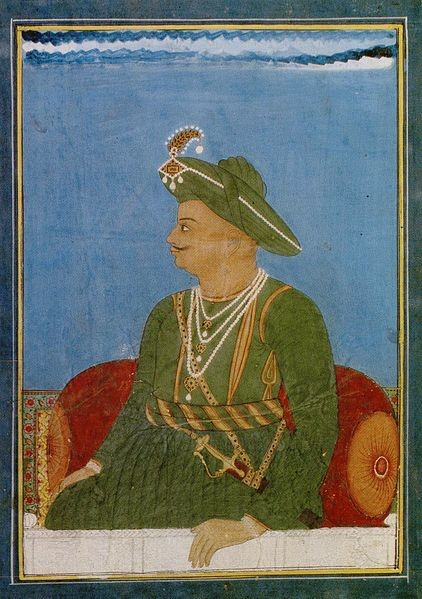

By the middle of the eighteenth century, Mysore emerged as a powerful kingdom under the leadership of Haider Ali and Tipu Sultan. They posed a serious threat to the English East India company’s commercial and political interests by increasing their proximity with the French and controlling the trade on the Malabar coast. And for this matter, Tipu Sultan refused the company to export some trading goods. This brought the company into direct conflict with Mysore and four Anglo-Mysore wars had been fought from 1767-1799, in which Tipu Sultan rose as a historical hero, who consistently gave a tough fight to the British but was finally defeated and killed in the battlefield.
Hyder Ali was born in 1721 and started his career as a horseman under the Mysore army of Nanjaraj and Devaraj. He succeeded in preventing Seringapatam in 1759 from Marathas, as a result of which he was rewarded by Nanjaraj with the title of “Fateh Haider Bahadur”. Gradually, Nanjaraja was overthrown by Haider Ali and assumed power but continued to accept Krshmaraja I’s over lordship. He captured some nearby territories like Coorg, Malabar, Bellary, and Cuddapah, etc. He even raided Maratha's territories and he is also known for his strong presence in the first and second Anglo- Mysore wars. He died in 1782 during the course of the Second Anglo-Mysore war due to cancer.

Suffren Meeting with Haider Ali, 26 July 1782 Engraved by J B Morret 1789
Jean Baptiste Morret (actif à Paris de 1790 à 1820), Public domain, via Wikimedia Commons
Tipu Sultan succeeded the Mysore throne after the death of his father Haider Ali, he ruled from 1782-99. He continued the second Anglo Mysore war till 1785. He fought the third and fourth Anglo-Mysore war in 1790-92 and 1799 respectively. He died in 1799 during the war defending his capital Seringpatam from the British.

Portrait of Tipu Sultan by an Anonymous Indian Artist in Mysore
Fowler&fowler at English Wikipedia, Public domain, via Wikimedia Commons
He made some reforms to run Mysore's economy and military effectively. He understood the importance of strengthening the economy to have a strong military. His economic reforms included the introduction of modern industries by importing foreign experts and extending support to many industries, sending ambassadors to foreign countries to develop foreign trade. He also attempted to increase the state income by doing away with the jagir system and hereditary possessions of the poligars. In his military reforms, he reorganized the infantry on the European lines and established a modern navy.
Tipu Sultan is also known as a “tiger of Mysore”, there are differences of opinions as to the reason for this title. According to one legend, once he was there in a forest with his friend and was suddenly confronted by a tiger, who tried to kill him. Accidently Tipu’s weapon fell off, so he fought with the tiger all unarmed but managed to get his weapon again and killed the tiger. From there onwards, he was called the “tiger of Mysore.” Some other theories with regard to this title, demonstrates due to his love with tigers made him select badges with pictures of tiger and even his soldiers’ uniforms had tiger stripes.
There were four wars that took place between the English East India Company −
This war began in 1767, in which the Nizam (Hyderabad), the Marathas(Deccan), and the English allied against Haider Ali. However, Haider Ali being a diplomat took Nizam and Marathas to his side. As a result, the British had to face a defeat with the signing of a treaty in 1769 called the Treaty of Madras.
Haider Ali alleged the English for not following the terms of the treaty of Madras when he was attacked by the Marathas and also he realized the French were more helpful than the English. Consequently, he allowed the French war material to Mysore through Mahe. As a result, the British tried to capture Mahe, which was under Haider’s protection. This made him furious and he declared war against the British. Haider Ali died of cancer and the war was carried out by his son Tipu Sultan. Ultimately this war came to an end with the signing of the Treaty of Mangalore.
This war took place in 1792-99, in this war Tipu sultan attacked one of the allies of the British, Travancore. The British again formed an alliance with the Marathas and Nizam against Mysore. Eventually, Tipu was defeated and made to sign the treaty of Seringpatam in 1792.
It took place in 1799 as Tipu decided to take revenge of the humiliating treaty of Seringapatam. Tipu established a large army against the British and refused to accept the subsidiary alliance, initiated by the British to expand their political control in India. Consequently, the fourth Anglo- Mysore war flared up between the British and Tipu on April 17,1799 and ended with the death of Tipu Sultan.
The kingdom of Mysore developed in the eighteenth century under the rule of two important rulers, Haider Ali and Tipu sultan. They even defended the kingdom from British rule for some time by controlling their trading activities in the region and maintaining friendly relations with the French. This infuriated the Britishers and paved the way for a series of wars, known as the Anglo-Mysore war. During the war, the Tipu sultan called the tiger of Mysore gave a tough time to the English by defeating them in the first two Anglo-Mysore wars. He died in 1799 during the course of the fourth Anglo- Mysore war and after that Mysore formed a subsidiary alliance with the British.
Q1. What was a subsidiary alliance?
Ans. The subsidiary alliance was a system started by Lord Wellesley to expand British rule in India. It refers to if an Indian ruler had to enter an alliance with the British for help from any kind of external threat to his kingdom. The British would provide them protection with certain terms and conditions as a part of the alliance.
Q2. Why was the treaty of Seringapatam was humiliating of Tipu Sultan?
Ans. Under this treaty half of the Mysore was taken over by the winning parties (English, Nizam and Marathas). Besides a war indemnity of three crores was forced on Tipu Sultan and his sons were made hostages but the English.
Q3. Who was Nanjaraja?
Ans. Nanjaraja was the Prime Minister under the ruling dynasty of Wodeyar in Mysore. He later became the de facto ruler though Krishna RajaI continued to be the de jure ruler.
Q4. What were terms of treaty of Madras?
Ans. The treaty provided the exchange of prisoners and restitution of conquests between the British and Mysore. The treaty also stated that the British would help in case Mysore was attacked by any other power.
Q5. What happed with Mysore after the death of Tipu Sultan?
Ans. The half of the kingdom of Mysore was divided between The English, Nizam and the Marathas. The new state of Mysore was handed over to the old ruling dynasty(Wodeyar)under Krishnaraja III, who accepted the subsidiary alliance. In 1831, William Bentinck took over the charge from company’s side in 1831 on the grounds of misgovernance.